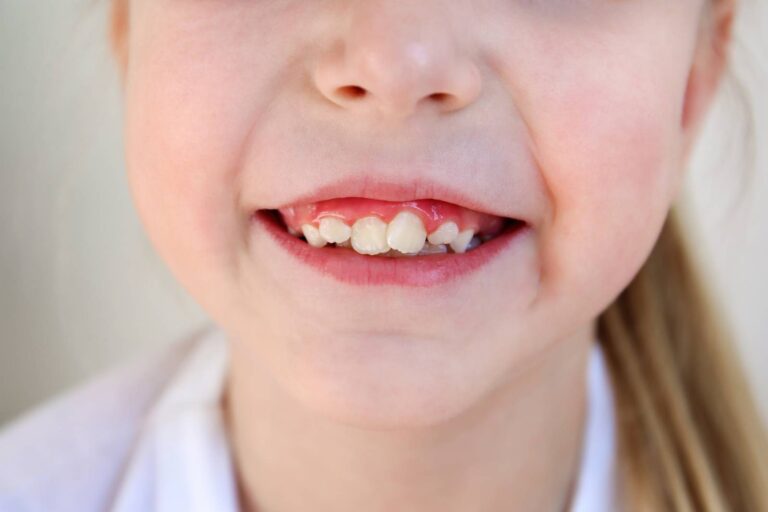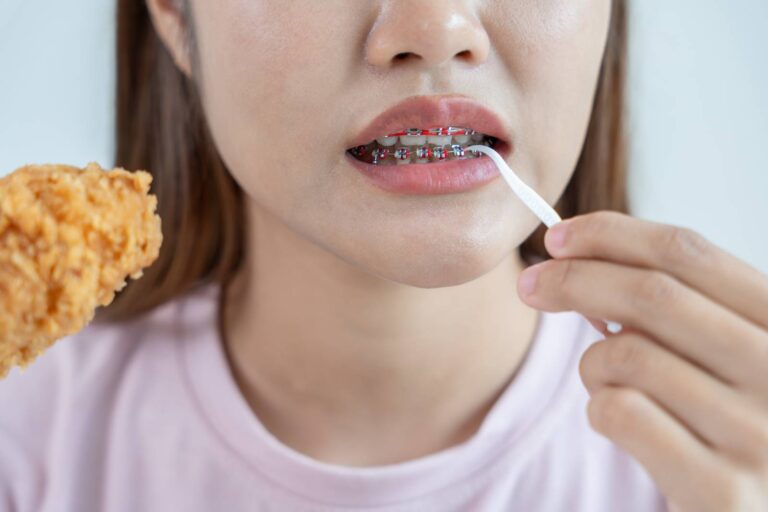Braces are one of the most common orthodontic treatments, but have you ever wondered, “Why do people need braces?” or “How do braces work?”
While many people get braces to achieve a straighter smile, orthodontic treatment goes beyond just aesthetics. Braces fix misaligned teeth, correct bite issues, and improve oral health and dental health—which can help prevent long-term problems like tooth decay, jaw pain, and even speech difficulties.
In this guide, we’ll explore why some people need braces, how braces work, and how long they take, plus other teeth straightening options available today.
What are Braces and Orthodontic Treatment?
Braces and orthodontic treatment are essential tools in addressing various dental issues, such as crooked teeth, crowded teeth, and bite problems. Orthodontic treatment involves the use of dental appliances, like braces, to gradually move teeth into their correct positions, thereby improving both function and appearance. Braces work by applying gentle, continuous pressure on the teeth, shifting them into alignment over time. This process can span several months to a few years, depending on the complexity of the dental issues being treated. By correcting these issues, orthodontic treatment not only enhances the aesthetics of your smile but also significantly boosts oral health, reducing the risk of tooth decay and gum disease.
Why Do People Need Braces?
People need braces for various reasons, often related to misalignment, spacing issues, or bite problems. If left untreated, these conditions can cause difficulty chewing, speech problems, and an increased risk of dental issues.
Orthodontic patients include individuals of all ages, from children to adults, highlighting the widespread need for braces.
Common Reasons Why People Need Braces: Crooked or Crowded Teeth
● Crooked or crowded baby teeth – Early signs that a child may need braces in the future.
● Gaps between teeth – Can cause shifting teeth and bite imbalances.
● Overbite (upper front teeth overlap lower teeth too much) – Can cause excessive tooth wear and jaw discomfort.
● Underbite (lower teeth overlap upper teeth) – May lead to chewing and speaking issues.
● Crossbite (misalignment of upper and lower teeth) – Can cause uneven wear and gum problems.
● Open bite (upper and lower teeth don’t meet when the mouth is closed) – May lead to difficulty chewing and speech problems.
At Enjoy Orthodontics, Dr. Felipe Porto carefully evaluates each patient’s needs to determine the best treatment plan for a healthy, confident smile.
Bite Issues and Teeth Alignment:
Bite issues, such as overbites and underbites, occur when the upper and lower teeth do not align properly. These misalignments can lead to a host of problems, including difficulty chewing and speaking and increased wear and tear on the teeth. Orthodontic treatment plays a crucial role in correcting these bite issues by moving the teeth into their proper positions, thereby improving the alignment of the upper and lower teeth. This realignment enhances oral health by making it easier to maintain dental hygiene and reduces the risk of future dental problems. Moreover, correcting bite issues can significantly improve the overall appearance of your smile, making it more balanced and aesthetically pleasing.
How Do Braces Work in Orthodontic Treatment?
Braces work by applying gentle, continuous pressure on the teeth, gradually moving them into the correct position over time.
The ultimate goal of braces is to achieve straight teeth, which enhances your smile and contributes to better dental health.
How Braces Move Your Teeth:
- Brackets are attached to teeth – These act as anchors for movement.
- An archwire connects the brackets – This wire applies pressure to guide teeth into alignment.
- Rubber bands and power chains may be added – These help correct bite issues and close gaps.
- Teeth shift as the bone remodels – The pressure from braces stimulates bone remodeling, allowing teeth to move and settle into their new position.
Braces require regular adjustments to continue applying the right amount of force for gradual movement.
How Long Do Braces Take?
The length of orthodontic treatment varies based on the complexity of the case and how well a patient follows their orthodontist’s instructions. Adult braces are increasingly common, and while they may take longer to achieve desired results compared to children, they are highly effective.
Typical Braces Timeline:
● Mild cases: 6-12 months
● Moderate cases: 12-24 months
● Severe cases: 24-36 months
Factors that affect treatment time include:
● Age – Braces often work faster in children and teens because their bones are still growing.
● Complexity of the case – Severe misalignment or bite problems take longer to correct.
● Patient compliance – Wearing rubber bands as instructed and maintaining good oral hygiene can help shorten treatment time.
At Enjoy Orthodontics, Dr. Porto provides personalized treatment plans to ensure patients achieve their best smile as quickly and efficiently as possible.
Why Do People Need Rubber Bands for Braces?
Rubber bands, or elastics, help correct bite alignment issues by applying additional force to move the teeth and jaw into the right position.
What Rubber Bands Do in Braces:
● Close gaps between teeth.
● Correct overbites, underbites, and crossbites.
● Improve jaw alignment for better function.
Wearing rubber bands as instructed is crucial—skipping them can delay treatment and prolong discomfort.
Why Do People Need Power Chain Braces?
Power chains are linked rubber bands that attach to brackets to speed up tooth movement.
Why Orthodontists Use Power Chains:
● Close gaps between teeth more quickly.
● Help align teeth in less time than regular elastics.
● Apply extra force for more efficient movement.
Power chains are often used in the later stages of braces treatment to fine-tune alignment.
Why Do People Need Headgear Braces?
Headgear is less common today, but it is sometimes necessary for severe bite issues that cannot be corrected with braces alone.
Why Some People Need Headgear:
● Corrects severe overbites and underbites.
● Helps adjust jaw growth in younger patients.
● Prevents the need for more invasive treatments like jaw surgery.
Headgear is typically worn at night and is recommended only for specific cases.
The Process of Getting Braces
The journey to a straighter smile with braces typically begins with a consultation with an orthodontist. The orthodontist will thoroughly examine your teeth and jaws during this initial appointment to determine the most effective treatment plan. If braces are deemed necessary, the orthodontist may scan your teeth to create a customized treatment plan tailored to your specific needs. Once the plan is set, the braces will be applied to your teeth. This involves attaching brackets to each tooth and connecting them with an archwire. Regular follow-up appointments are essential for adjustments, ensuring the teeth move as planned. These adjustments are crucial for the gradual and precise movement of teeth into their desired positions.
Benefits of Orthodontic Treatment
Orthodontic treatment offers a multitude of benefits that extend beyond just achieving a beautiful smile. One of the primary advantages is improved oral health. By straightening teeth and correcting bite issues, orthodontic treatment makes it easier to clean teeth effectively, thereby reducing the risk of tooth decay, gum disease, and dental plaque buildup. Additionally, a well-aligned bite can alleviate strain on the jaw, reducing the risk of jaw pain and other related issues. Beyond health benefits, orthodontic treatment can significantly enhance your appearance and boost your confidence. Whether you opt for traditional metal braces, Invisalign, or other orthodontic options, there is a solution to fit every lifestyle and budget, ensuring that everyone can achieve a healthy, confident smile.
Teeth Straightening Options Besides Braces
Braces aren’t the only way to straighten teeth. Depending on the case, other orthodontic treatments may be an option. These options can also address issues like missing teeth, which can affect the spacing and alignment of your smile.
1. Clear Aligners (Spark, Invisalign, and others)
● Nearly invisible and removable.
● Great for mild to moderate cases.
● Requires wearing at least 22 hours per day for best results.
2. Lingual Braces vs. Traditional Metal Braces
● Braces are placed behind the teeth, making them invisible.
● Work similarly to traditional braces but can take longer.
3. Retainers for Minor Adjustments
● Retainers are used after braces but can also correct very small shifts in teeth.
● Best for preventing further movement rather than major corrections.
At Enjoy Orthodontics, Dr. Porto helps patients explore all available teeth straightening options to find the best fit for their needs and lifestyle.
Final Thoughts: Why Braces Are Worth It
Braces aren’t just about cosmetic improvements—they help fix alignment, improve oral health, and prevent future dental issues.
Key Takeaways:
● People need braces for crooked teeth, bite problems, gaps, and overall oral health improvements.
● Braces work by applying gentle pressure, shifting teeth into proper alignment.
● Most people wear braces for 12-24 months, but complex cases may take longer.
● Rubber bands, power chains, and even headgear help with specific alignment corrections.
● There are alternative teeth straightening options like Invisalign and lingual braces for those looking for more discreet options.
At Enjoy Orthodontics, Dr. Felipe Porto and his team offer personalized orthodontic care to help every patient achieve a beautiful, healthy smile.
Thinking about braces or other teeth straightening options? Schedule a consultation today!





